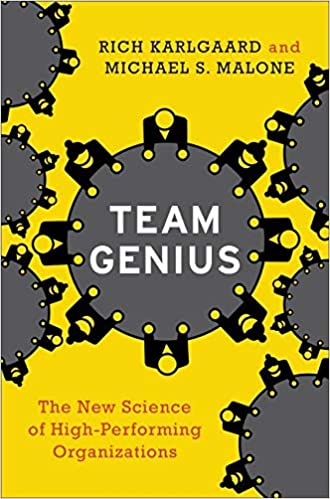
Team Genius: The New Science of High-Performing Organizations - by Rich Karlgaard and Michael S. Malone
Date read: 2023-01-15How strongly I recommend it: 6/10
(See my list of 150+ books, for more.)
Go to the Amazon page for details and reviews.
Meant to be the science behind the best team combinations (e.g., size, type, skillsets, etc.) it falls short of expectations. They've done a great job classifying the different types of teams, but have done little to help optimize teams.
Contents:
My Notes
From experience and research, the optimum team size is 5–7 members. The team size that continues to function effectively is 4–9 members. Teams are known to function cohesively with a size up to 12 members.
The figure of 150 seems to represent the maximum number of individuals with whom we can have a genuinely social relationship, the kind of relationship that goes with knowing who they are and how they relate to us.
There are other Dunbar numbers as well:
Harvard psychologist J. Richard Hackman once said, “Big teams usually wind up just wasting everybody’s time.”
The fallacy is that bigger teams are better than small ones because they have more resources to draw upon. A colleague and I once did some research showing that as a team gets bigger, the number of links that need to be managed among members goes up at an accelerating, almost exponential rate. It’s managing the links between members that gets teams into trouble. My rule of thumb is no double digits. In my courses, I never allow teams of more than six students.
Top-performing leaders have been shown, on average, to elicit laughter from their subordinates at least twice as often as their less successful counterparts. One reason for this is that laughter appears to increase both creativity and trust within teams. Perhaps more surprisingly, humor also makes audiences listen and retain more of a presentation or conversation.
When the team members think the boss is happy, they feel liberated to try out new ideas; and when they think the boss is unhappy, they hunker down into survival mode. This is probably why positive emotions result in more cooperative and conciliatory behavior.
Communicate regularly, but not constantly, and to use that communication for the dissemination of new information, not for setting boundaries on members’ efforts.
The best teams enjoy a mix of old friends and newcomers. In this way, the team members are comfortable with each other and readily exchange ideas, but they are not so comfortable that they stifle creativity in each other.
Research shows that groups perform best when their task and outcomes are either purely the product of group work or purely the product of individual effort. Hybrid groups—once again, the in-between position, in which tasks and rewards have individual as well as group elements—inevitably struggle with interactions, group stability, and member satisfaction. In hybrid groups, cooperation norms are weak.
Great teams do the following:
Collaboration will not compensate for an inadequately endowed team. Of course, the most effective teams combine the required aggregate abilities, the proper role assignments, and a lot of talking.
When it comes to teams, traditional definitions of “diversity” are meaningless. Cognitive diversity—how people think—is all.
Studies have found that the optimal balance of people on radical-innovation teams requires that 50 percent of the members have the following distribution of personality types:
The solitary inventor may come up with an earthshaking new idea or invention, but you are better off betting on a team to bring the idea to life.
So just hiring more women as per Woolley works for Page only if those women come from sufficiently unusual backgrounds to think differently from their new teammates. Otherwise, if they are merely cut from the same cloth as the male members of the team, they will have only a minor impact (that is, there will be a comparatively small cognitive difference between the sexes). What matters most are differences in culture, class, and aptitudes.
The more diverse the team, the more hands-on management it will need.